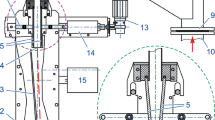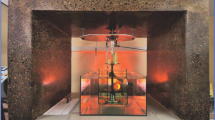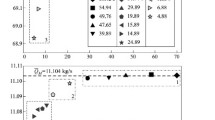The present article discusses the provision of metrological support for measuring liquid mass and volume in a flow, as well as liquid mass and volumetric flow rates within the microflow range of 10−5 to 103 mL/min, to satisfy needs of leading sectors of the world economy. Drawing on an analytical review, the main metrological and performance characteristics of national standards are presented. The article uses the dynamic weighing method to outline the basic principles of flow generation in national gravimetric and volumetric standards during liquid mass and volume measurements. The design and operating principles of key modules available in national standards are considered. Methods for supplying liquids to collection vessels and their design are described, taking into account the necessity to minimize liquid evaporation, as well as the impact of capillary force and buoyancy. The primary sources of uncertainty in measuring the mass and volume of liquid using the dynamic weighing method are considered, along with methods for minimizing such uncertainties. A modified model for the dynamic measurement of liquid mass flow rate is proposed, which takes the primary sources of uncertainty into account. The influence of various sources of uncertainty on the metrological characteristics of national standards is discussed.


Similar content being viewed by others
References
P. Lucas, M. Ahrens, J. Geršl, et al., Biomed. Tech., 60, 317–335 (2015), https://doi.org/10.1515/bmt-2014-0132.
C. Corleto, P. Claudel, M. Dobre, et al., Meas. Sci. Technol., 29, No. 7, 070101 (2018), https://doi.org/10.1088/1361-6501/aabb6d.
C. David and P. Claudel, MAPAN J. Metrol. Soc. I., 26, 203–209 (2011), https://doi.org/10.1007/s12647-011-0019-0.
P. P. Kremlevskii, Flow and Quantity Meters. Handbook, Book 2, E. A. Shornikov (ed.), Politekhnika, St. Petersburg (2004), 5th ed.
J. C. Lötters, T. S. Lammerink, J. Groenesteijn, et al., Micromachines, 3, 194–203 (2012), https://doi.org/10.3390/mi3010194.
A. R. Tukhvatullin, A. V. Shchelchkov, and V. A. Fafurin, “GET 63-2019 State primary special standard of units of mass and volume of liquid in a flow and of mass and volume flow rates of a liquid,” Izmer. Tekhn., No. 2, 3–8 (2021), 10.32446/0368-1025it.2021-2-3-8.
H. Bissig, M. Tschannen, and M. de Huu, Flow Meas. Instrum., 73, 101744 (2020), https://doi.org/10.1016/j.flowmeasinst.2020.101744.
M. Benkova and I. Mikulecky, “Primary standard and traceability chain for microflow of liquids,” 16th Int. Flow Measurement Conf., FLOMEKO 2013, Paris, France, Sept. 24–26, 2013, IMEKO, Paris (2013), pp. 44–49.
M. Benkova and F. Schweitzer, “New primary standard with piston prover for microflow of liquids,” in: 18th Int. Flow Measurement Conf., FLOMEKO 2019, Lisbon, Portugal, June 26–28, 2019, IMEKO, Lisbon (2019), pp. 463–467.
C. Melvad and J. Frederiksen, “The progress of gravimetric primary standards for liquid flow calibration at the Danish technological institute from 500 m3/h to 10−9 m3/h,” in: 16th Int. Flow Measurement Conference, FLOMEKO 2013, Paris, France, Sept. 24–26, 2013, IMEKO, Paris (2013), pp. 218–221.
P. Salipante, S. D. Hudson, J. W. Schmidt, and J. D. Wright, Exp. Fluids, 58, No. 7, 85 (2017). https://doi.org/10.1007/s00348-017-2362-6.
J. D. Wright and J. W. Schmidt, “Reproducibility of liquid micro-flow measurements,” in: 18th Int. Flow Measurement Conference, FLOMEKO 2019, Lisbon, Portugal, June 26–28, 2019, IMEKO, Lisbon (2019), pp. 604–622.
E. Batista, I. Godinho, R. F. Martins, et al., Flow Meas. Instrum., 75, 101789 (2020). https://doi.org/10.1016/j.flowmeasinst.2020.101789.
B. H. Sirenden, G. Zaid, P. Prajitno, and Hafid, “Development of volumetric micro-flow calibration system using FPGA for medical application,” in: XXI IMEKO World Congress Measurement in Research and Industry, Prague, Czech Republic, Aug. 30 – Sept. 4, 2015, IMEKO, Prague (2015), pp. 116100.
T. Chinarak, K. Yooyartmak, and P. Wongthep, J. Phys. Conf. Ser., 1144, No. 1, 012081 (2018), https://doi.org/10.1088/1742-6596/1144/1/012081.
R. Doihara, T. Shimada, K.-H. Cheong, and Y. Terao, Flow Meas. Instrum., 50, 90–101 (2016), https://doi.org/10.1016/j.flowmeasinst.2016.06.014.
H. Bissig, H. T. Petter, P. Lucas, et al., Biomed EngBiomed Tech., 60, 301–316 (2015), https://doi.org/10.1515/bmt-2014-0145.
T. H. Platenkamp, W. Sparreboom, G. H. J. M. Ratering, et al., Micromachines, 6, No. 4, 473–486 (2015), https://doi.org/10.3390/mi6040473.
Author information
Authors and Affiliations
Corresponding author
Additional information
Translated from Izmeritel’naya Tekhnika, No. 7, pp. 32–41, July, 2021.
Rights and permissions
About this article
Cite this article
Tukhvatullin, R.R., Shchelchkov, A.V. Current Design Trends in the Modules of National Standards for the Units of Liquid Volumetric Flow Rate (Volume) within the Range of 10−5 to 103 mL/min. Meas Tech 64, 562–572 (2021). https://doi.org/10.1007/s11018-021-01972-8
Received:
Accepted:
Published:
Issue Date:
DOI: https://doi.org/10.1007/s11018-021-01972-8




